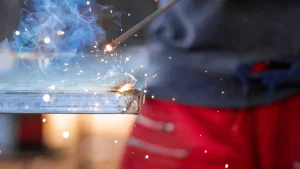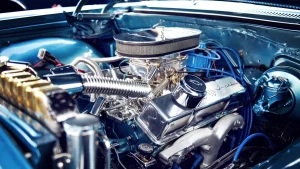
Pyrolytische Kohlenstoffbeschichtung, a material formed through the pyrolysis process, exhibits exceptional properties that make it indispensable in modern industries. Its biocompatibility, thermal resistance, and chemical inertness enable its use in diverse fields. Industries such as aerospace, automotive, and medical rely on this pyrocarbon coating for its durability and efficiency. The global market for pyrolytic carbon coating continues to grow, driven by advancements in material science and increasing demand for sustainable solutions. For instance, aerospace applications benefit from its integration into silicon carbide components, enhancing performance in extreme conditions. Additionally, the silicon carbide application in various technologies showcases the versatility of this material. Companies like Ningbo VET Energy Technology Co. contribute to innovations in this field, including the development of a silicon carbide factory, ensuring its relevance in cutting-edge technologies.
Wichtigste Erkenntnisse
- Pyrolytische Kohlenstoffbeschichtung is important in fields like space and healthcare because it is strong, safe for the body, and handles heat well.
- This coating helps medical tools like heart valves and bone implants work better by stopping blood clots and lasting a long time.
- New ideas in pyrolytic carbon improve green energy, making fuel cells and solar panels work more efficiently.
Understanding Pyrolytic Carbon Coating
How pyrolytic carbon coating is created
Pyrolytic carbon coating is produced through a process called pyrolysis, which involves the thermal decomposition of hydrocarbons. This process typically occurs in a chemische aufdampfung (CVD) chamber under controlled conditions. The steps include:
- Purging the chamber with nitrogen and hydrogen gases.
- Heating the chamber to 700 °C in a hydrogen atmosphere for one hour.
- Replacing the hydrogen with a hydrogen-methane gas mixture.
- Gradually increasing the temperature to 1100 °C over 40 minutes.
- Allowing methane to decompose spontaneously at 1100 °C, forming hydrocarbon molecules that deposit onto the substrate.
This method ensures the formation of a durable and uniform coating. During carbonization, coke and volatile products are produced, which degrade into pyrolytic carbon, water, and gas. The result is a material with exceptional properties suitable for various applications.
Structure and composition of pyrolytic carbon coating
Pyrolytic carbon coating has a unique molecular structure. It resembles graphite but features covalent bonding between graphene sheets due to production imperfections. This structure consists of randomly oriented zones, unlike the organized layers found in natural graphite. The material is composed of small, lamellar graphitic ribbons and contains minimal amorphous carbon. Its strong optical absorption and sp2 hybridization contribute to its distinct thermal and electrical properties.
The layered structure of pyrolytic carbon includes wavy, twisted planes of carbon atoms arranged in a hexagonal pattern. These layers are parallel but randomly rotated, resulting in high anisotropy in physical properties.
Key differences from other carbon-based materials
Pyrolytic carbon coating stands out from other carbon-based materials like graphite and diamond. Unlike graphite, it exhibits some covalent bonding between graphene sheets, enhancing its durability and wear resistance. It is also biocompatible and thromboresistant, making it ideal for medical applications. Additionally, its anisotropic nature and strong intra-layer bonds provide superior thermal and chemical stability compared to other forms of carbon.
Ningbo VET Energy Technology Co. leverages these unique properties to develop advanced solutions, ensuring the material’s relevance in cutting-edge industries.
Unique Properties of Pyrolytic Carbon Coating
Biocompatibility and medical relevance
Pyrolytische Kohlenstoffbeschichtung is highly valued in the medical field due to its biocompatibility. This property ensures that the material does not trigger adverse reactions when implanted in the human body. Its thromboresistance further enhances its suitability for medical devices by resisting blood clot formation. These qualities make it a preferred choice for applications such as artificial heart valves and orthopedic implants.
The table below highlights the key properties that contribute to its medical relevance:
| Eigentum | Beschreibung |
|---|---|
| Biocompatibility | Does not elicit adverse reactions when implanted |
| Thromboresistance | Resists blood clotting |
| Langlebigkeit | Good durability |
| Wear Resistance | Good wear resistance |
| Stärke | Good strength |
Medical devices benefiting from this coating include anatomically correct orthopedic implants and hand joint replacements, such as metacarpophalangeal and interphalangeal joints. Artificial heart valves also utilize thick pyrolytic carbon coatings for enhanced performance.
Thermal resistance and durability
Pyrolytic carbon coating exhibits exceptional thermal resistance, making it suitable for high-temperature environments. It can withstand temperatures ranging from 315°C to 1000°C, maintaining its mechanical properties even under extreme conditions. During the critical phase of polymer chain conversion, between 300°C and 400°C, the material undergoes structural changes that enhance its durability. Compared to other materials, it offers superior thermal stability, ensuring reliable performance in demanding applications.
| Temperature Range (°C) | Beschreibung |
|---|---|
| 315 – 1000 | Investigated for optimal mechanical properties |
| 300 – 400 | Critical phase for polymer chain conversion to pyrolytic carbon |
This durability, combined with its resistance to wear, makes it an ideal choice for industries requiring long-lasting materials.
Chemical inertness and corrosion resistance
Pyrolytic carbon coating is chemically inert, meaning it resists reactions with most chemicals. This property ensures that the material remains stable in corrosive environments, such as those involving strong acids or bases. Its corrosion resistance extends the lifespan of components, reducing maintenance costs and improving reliability. These characteristics make it indispensable in industries like aerospace, where materials must endure harsh conditions without degradation.
Ningbo VET Energy Technology Co. continues to innovate in this field, leveraging the einzigartige eigenschaften of pyrolytic carbon coating to develop advanced solutions for modern industries.
Applications in Medicine
Use in heart valve prosthetics
Pyrolytic carbon coating has revolutionized heart valve prosthetics by offering unmatched performance and longevity. Its biocompatibility ensures that the material integrates seamlessly with human tissue, reducing the risk of adverse reactions. Thromboresistance, another critical property, minimizes blood clot formation, a common issue with other materials like metals and plastics. The durability and wear resistance of pyrolytic carbon further enhance the lifespan of heart valves, making them a superior choice for patients requiring long-term solutions.
Advancements in pyrolytic carbon production have eliminated silicon carbide inclusions, which previously compromised thromboresistance. This innovation has resulted in tougher and stronger materials, ensuring better outcomes for patients. Companies like Ningbo VET Energy Technology Co. continue to drive these advancements, solidifying the role of pyrolytic carbon in modern medical applications.
Role in orthopedic implants
Orthopedic implants benefit significantly from pyrolytic carbon coatings, marketed as “PyroCarbon” for joint replacements. These coatings improve implant performance and longevity, making them ideal for procedures like metacarpophalangeal replacements. The U.S. FDA has approved their use in hand surgeries, highlighting their safety and effectiveness.
Key properties of pyrolytic carbon coatings in orthopedic implants include:
| Eigentum | Leistung |
|---|---|
| Biocompatible | Does not elicit adverse reactions |
| Thromboresistant | Resists blood clotting |
| Langlebigkeit | Enhances longevity of implants |
| Wear Resistance | Reduces wear over time |
| Stärke | Improves overall implant functionality |
These attributes ensure that orthopedic implants coated with pyrolytic carbon provide patients with reliable and long-lasting solutions.
Other medical innovations
Beyond heart valves and orthopedic implants, pyrolytic carbon coatings have found applications in other groundbreaking medical technologies. Artificial hearts utilize this material for its durability and biocompatibility, ensuring reliable performance under demanding conditions. Blood vessel stents also benefit from pyrolytic carbon’s thromboresistance, reducing the risk of clot formation and improving patient outcomes. These innovations demonstrate the versatility of pyrolytic carbon in addressing complex medical challenges.
Ningbo VET Energy Technology Co. continues to explore new possibilities for pyrolytic carbon coatings, driving innovation in the medical field and beyond.
Applications in Aerospace and Defense
Thermal protection systems for spacecraft
Spacecraft face extreme temperatures during re-entry into Earth’s atmosphere. Pyrolytic carbon coating plays a critical role in wärmeschutzsysteme by providing exceptional heat resistance. Its unique structure allows it to withstand temperatures exceeding 3000°C without degrading. This capability ensures that spacecraft components remain intact under intense thermal stress. The coating also prevents oxidation, which can weaken materials exposed to high heat and oxygen. These properties make pyrolytic carbon an essential material for heat shields and other thermal barriers in space exploration.
Coatings for high-performance components
High-performance aerospace components demand materials that can endure extreme conditions. Pyrolytic carbon coating enhances the durability and functionality of these components. Its chemical inertness and thermal stability make it ideal for applications requiring precision and reliability. Examples of aerospace components utilizing this coating include:
- Missile nose cones
- Rocket motors
These components benefit from the coating’s ability to maintain structural integrity under high-speed flight and extreme heat. By improving performance and extending the lifespan of critical parts, pyrolytic carbon coating supports advancements in aerospace technology.
Advanced military technologies
Military applications often require materials that combine strength, heat resistance, and stealth capabilities. Pyrolytic carbon coating meets these demands through its versatile properties. The table below highlights its role in advanced military technologies:
| Anwendung | Beschreibung |
|---|---|
| Missile Nose Cones | Used for heat resistance in high-speed flight. |
| Rocket Motors | Provides structural integrity under extreme heat. |
| Heat Shields | Protects equipment from intense thermal exposure. |
| Graphite-Reinforced Plastic | Enhances material properties for durability. |
| Coating Nuclear Fuel Particles | Improves safety and performance in reactors. |
These applications demonstrate the coating’s importance in modern defense systems. Companies like Ningbo VET Energy Technology Co. continue to innovate in this field, ensuring the material’s relevance in cutting-edge military technologies.
Applications in Electronics and Energy
Halbleiterherstellung
Pyrolytic carbon coating plays a vital role in halbleiterherstellung due to its unique properties. Its ability to enhance light absorption across a wide spectrum makes it highly effective when applied to black silicon. This feature improves the efficiency of semiconductor devices. The uniformity and conformality of pyrolytic carbon films allow them to cover large areas, which is essential for modern semiconductor production. These coatings also exhibit exceptional robustness, enabling their use in micro- and nanoelectromechanical systems (MEMS/NEMS).
Ningbo VET Energy Technology Co. has been at the forefront of developing advanced pyrolytic carbon solutions for semiconductor applications. Their innovations ensure that these coatings meet the stringent demands of the electronics industry.
Energy storage systems
Energy storage systems benefit significantly from the thermal and chemical stability of pyrolytic carbon coating. This material enhances the performance of components like electrodes in batteries and capacitors. Its high conductivity ensures efficient energy transfer, while its chemical inertness prevents degradation over time. These properties make it an ideal choice for next-generation energy storage technologies, including lithium-ion batteries and supercapacitors.
By leveraging pyrolytic carbon coatings, companies like Ningbo VET Energy Technology Co. are driving advancements in sustainable energy solutions. Their contributions help improve the efficiency and lifespan of energy storage devices.
Advanced sensors and devices
Pyrolytic carbon coating has revolutionized the development of advanced sensors and devices. Its biocompatibility and chemical inertness make it suitable for biomedical sensors, where it increases sensitivity in electrochemical experiments. Additionally, its durability and thin-film capabilities allow it to function as a membrane material in MEMS and NEMS. These features enable the creation of highly precise and reliable sensors for various applications.
Ningbo VET Energy Technology Co. continues to innovate in this area, ensuring that pyrolytic carbon coatings remain integral to cutting-edge sensor technologies.
Future Potential of Pyrolytic Carbon Coating
Innovations in nanotechnology
Nanotechnology continues to unlock new possibilities for pyrolytic carbon coating. Recent advancements include the co-deposition of carbon and silicon carbide through chemical vapor deposition (CVD). This process creates coatings that enhance the performance and durability of biomedical devices. For instance, nanometer-thin pyrolytic carbon films applied to black silicon improve electrochemical measurements and shield against electromagnetic radiation.
| Innovation/Application | Beschreibung |
|---|---|
| Black Silicon | Nanometer-thin pyrolytic carbon films enhance light absorption and shielding. |
The growing demand for high-performance materials in automotive, aerospace, and medical industries drives innovation in coating technologies. These advancements highlight the versatility of pyrolytic carbon in addressing complex challenges across multiple sectors.
Sustainable energy solutions
Pyrolytic carbon coating plays a pivotal role in advancing sustainable energy technologies. Its exceptional resistance to wear, corrosion, and high temperatures makes it ideal for components in fuel cells and solar panels. These attributes enhance the efficiency and durability of renewable energy systems. For example, fuel cells benefit from the coating’s ability to maintain stability under extreme conditions, ensuring long-term performance.
As the renewable energy sector expands, pyrolytic carbon coatings will likely become integral to developing more efficient and reliable energy solutions. Companies like Ningbo VET Energy Technology Co. are at the forefront of these innovations, driving progress in sustainable energy applications.
Emerging research and development
Research into pyrolytic carbon coating continues to evolve, focusing on diverse applications across aerospace, automotive, renewable energy, and medical sectors. North America leads in aerospace and defense investments, while Europe emphasizes sustainable energy solutions. The Asia-Pacific region experiences rapid growth due to industrial expansion and increased automotive production.
These regional trends highlight the global potential of pyrolytic carbon coatings. As industries invest in advanced materials, the scope for innovation and application will only expand, ensuring the material’s relevance in future technologies.
Pyrolytic carbon coating has become a cornerstone in modern industries due to its exceptional properties. Its resistance to wear, corrosion, and high temperatures enhances the performance of components in demanding environments. Industries like aerospace, medical, and automotive rely on this material for critical applications, such as heart valves and thermal protection systems.
The global market for pyrolytic carbon coatings continues to expand, driven by innovations in manufacturing and rising demand across sectors. Future advancements in material science and sustainable energy solutions promise to unlock even greater potential for this versatile material.
FAQ
What makes pyrolytic carbon coating unique compared to other materials?
Pyrolytic carbon coating offers exceptional biocompatibility, thermal resistance, and chemical inertness. These properties make it ideal for medical, aerospace, and energy applications. Ningbo VET Energy Technology Co. specializes in its innovations.
Can pyrolytic carbon coating be used in renewable energy systems?
Yes, pyrolytic carbon coating enhances the langlebigkeit und effizienz of components in fuel cells and solar panels. Its resistance to wear and corrosion ensures long-term performance in sustainable energy technologies.
How does Ningbo VET Energy Technology Co. contribute to advancements in pyrolytic carbon coating?
Ningbo VET Energy Technology Co. develops cutting-edge solutions for industries like aerospace, medicine, and energy. Their innovations improve the performance and reliability of pyrolytic carbon-coated components.





